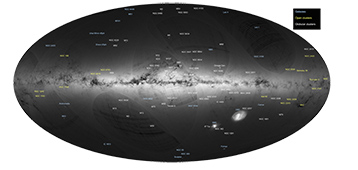With one billion stars mapped in a thousand days, European researchers have shown that they are not afraid to tackle the most daunting tasks. The work was carried out by 450 researchers from 25 European countries, including around a hundred scientists from France, mainly at the CNRS, Observatoire de Paris and Observatoire de la Côte d’Azur[1], with major participation by the French space agency CNES. Using the Gaia spacecraft, launched on 19 December 2013, scientists have catalogued the position of 1.15 billion stars, and in addition measured the velocity and distance of two million of them relative to the Sun. ESA[2] and the European consortium DPAC[3] are releasing the mission's first findings on September 14. The announcement represents the most precise and detailed sky survey ever carried out.
The Gaia spacecraft both rotates and orbits around the Earth, while surveying the sky with its two telescopes. Equipped with 106 CCDs forming the equivalent of a camera with a resolution of a billion pixels, it surveys 50 million stars per day, each time carrying out ten measurements, which represents a total of 500 million data points per day. This huge amount of information has been used to draw up a catalog of the positions in the sky of 1.15 billion stars. The precision ranges from 0.5 to 15 milliarcseconds (a milliarcsecond is equivalent to the angle subtended by a 1 euro coin at a distance of 4 000 km).
 The small white dots scattered across the map correspond to known sources, galaxies, globular clusters and open clusters. Their most common names are shown above or next to the source. The two large galaxies in the southern hemisphere are the Magellanic Clouds. In a small dot such as M5 in the center of the map Gaia has detected several thousand stars. © ESA/Gaia/DPAC. Image generated by: André Moitinho & Márcia Barros (CENTRA - University of Lisbon) and François Mignard (OCA-CNRS) on behalf of DPAC.
The small white dots scattered across the map correspond to known sources, galaxies, globular clusters and open clusters. Their most common names are shown above or next to the source. The two large galaxies in the southern hemisphere are the Magellanic Clouds. In a small dot such as M5 in the center of the map Gaia has detected several thousand stars. © ESA/Gaia/DPAC. Image generated by: André Moitinho & Márcia Barros (CENTRA - University of Lisbon) and François Mignard (OCA-CNRS) on behalf of DPAC.
Including 200 million more stars than initially planned, the catalog will enable researchers to compile valuable statistics about various types of bodies, which would be impossible without such a huge survey. For instance, the catalog contains data for 250,000 quasars, as well as for 3 000 Cepheid and RR Lyrae variable stars[4]. The Gaia mission has provided the light curves of the variable stars, in other words, the changes in their brightness, which will help scientists to shed light on the physical processes governing these stars.
The positions of a subset of two million stars were also compared with measurements carried out 23 years earlier by ESA's Hipparcos mission. The difference was used to calculate the velocity and distance of these bodies relative to the Solar System. Collection of the catalog data ended in September 2015. However, since Gaia continues to gather information, the researchers intend, in similar fashion, to compare the future positions of stars with those given in the catalog. By the end of 2017, they should therefore have obtained the velocity and distance of all one billion stars.
French organizations have played a leading role in the mission, and are represented in the consortium by around a hundred researchers, engineers and technicians. They take part in the many tasks essential to the success of the Gaia mission, such as organizing the ground-based observations needed to process the data, providing ephemeris data for the Solar System, carrying out daily observation of the Gaia spacecraft using optical instruments (in order to know its position and velocity to a very high degree of precision), validating data processing, etc.
The laboratories taking part are:
- Laboratoire Galaxies, Étoiles, Physique et Instrumentation (CNRS/Observatoire de Paris/Université Paris Diderot)
- Laboratoire Systèmes de Référence Temps-Espace (CNRS/Observatoire de Paris/UPMC)
- Laboratoire d’Etudes du Rayonnement et de la Matière en Astrophysique et Atmosphères (CNRS/Observatoire de Paris/ENS Paris/UPMC/Université de Cergy-Pontoise)
- Institut de Mécanique Céleste et de Calcul des Éphémérides (CNRS/Observatoire de Paris/UPMC/Université de Lille)
- Laboratoire Lagrange (CNRS/Observatoire de la Côte d’Azur/Université de Nice Sophia Antipolis)
- Laboratoire d’Astrophysique de Bordeaux (CNRS/Université de Bordeaux)
- Observatoire Astronomique de Strasbourg (CNRS/Université de Strasbourg)
- Laboratoire Univers, Transport, Interfaces, Nanostructures, Atmosphère et Environnement, Molécules (CNRS/Université de Franche-Comté)
- Laboratoire Univers et Particules de Montpellier (CNRS/Université Montpellier)